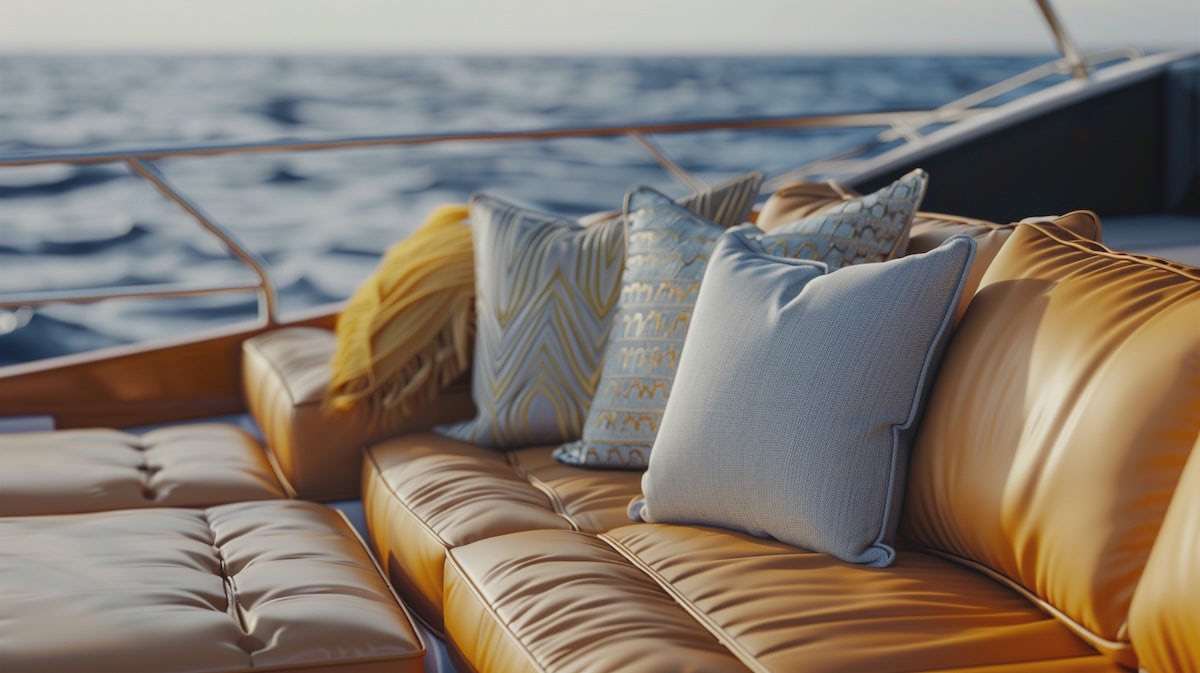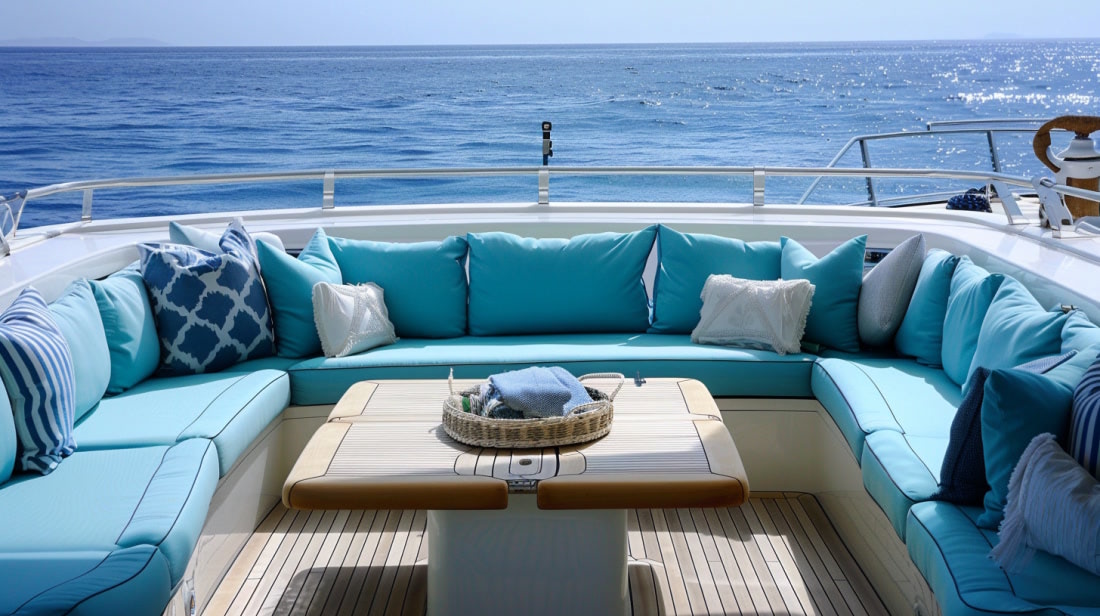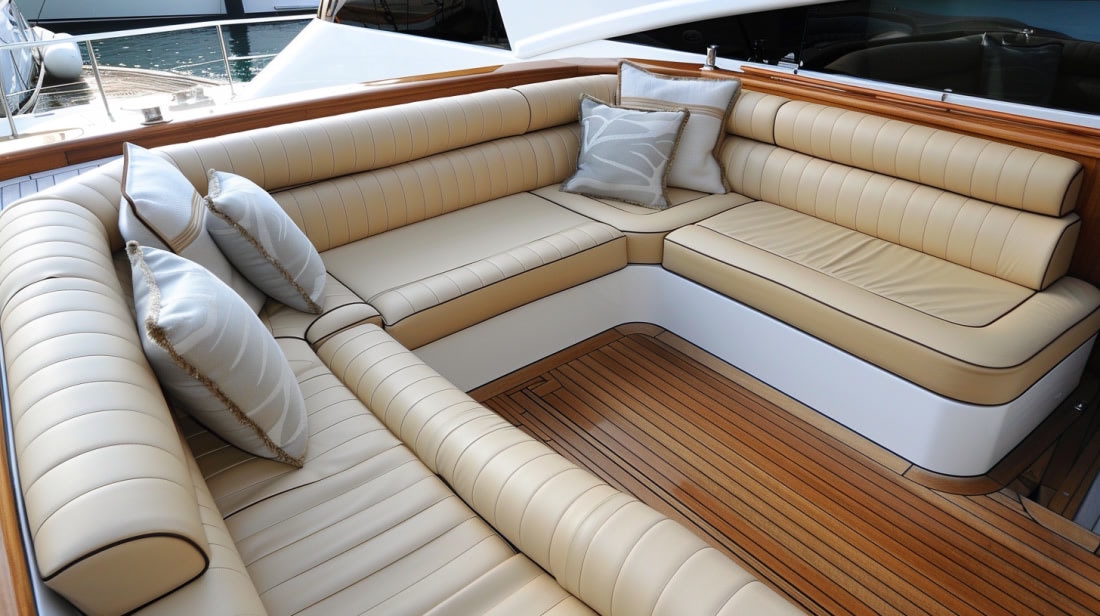Marine upholstery care and maintenance is an essential aspect of owning a boat. Taking care of your boat’s upholstery is important for keeping it looking good and lasting a long time, no matter what type of boat you have. Boats have upholstery on seats, cushions, and other surfaces. It gets exposed to the sun, water, and dirt. Neglecting upholstery maintenance can lead to damage, mold, and a decrease in the overall value of your boat. In this article, we will explore the importance of maintaining your boat’s upholstery and provide tips for regular cleaning and maintenance.
Key Takeaways
- Regular cleaning and maintenance of marine upholstery is crucial for the longevity and aesthetics of your boat.
- Mold and mildew can be prevented by keeping the upholstery dry and using appropriate cleaning products.
- Sun damage can be minimized by using protective covers and applying UV-resistant products.
- Different types of boat materials require different cleaning and maintenance techniques.
- DIY cleaning and maintenance techniques can be effective, but hiring a professional may be necessary for more severe damage or specialized materials.
Understanding the Importance of Upholstery Maintenance for Your Boat
Neglecting upholstery maintenance can have significant consequences for your boat. Over time, dirt, grime, and saltwater can accumulate on the upholstery, causing it to deteriorate and lose its original appearance. Stains from food and drinks can also become embedded in the fabric or leather, making them difficult to remove. Additionally, exposure to the sun’s UV rays can cause fading and discoloration of the upholstery.
Regular maintenance is essential to extend the life of your boat’s upholstery. By cleaning it regularly and protecting it from the elements, you can prevent damage and maintain its original beauty. Regular cleaning removes dirt and grime that can cause abrasion and wear on the fabric or leather. It also helps prevent stains from setting in and becoming permanent. By taking care of your boat’s upholstery, you can ensure that it remains in good condition for years to come.
Tips for Regular Cleaning of Marine Upholstery
Regular cleaning is crucial for maintaining your boat’s upholstery. Here are some practical tips for cleaning marine upholstery:
1. Vacuum regularly: Use a handheld vacuum or a brush attachment to remove loose dirt and debris from the upholstery. This will prevent dirt from becoming embedded in the fabric or leather.
2. Use a mild detergent: Mix a small amount of mild detergent with water and use a soft brush or sponge to clean the upholstery. Avoid using harsh chemicals or abrasive cleaners, as they can damage the fabric or leather.
3. Spot clean stains: If you notice any stains on the upholstery, spot clean them immediately. Use a mild detergent or a specialized upholstery cleaner and gently blot the stain with a clean cloth. Avoid rubbing the stain, as it can spread and make it more difficult to remove.
4. Rinse thoroughly: After cleaning, rinse the upholstery thoroughly with clean water to remove any residue from the detergent or cleaner. This will prevent the upholstery from becoming sticky or attracting more dirt.
5. Allow to dry completely: After cleaning, allow the upholstery to air dry completely before using it again. Avoid using heat sources such as hairdryers, as they can damage the fabric or leather.
Regular cleaning is essential to prevent dirt and grime from accumulating on your boat’s upholstery. By following these tips, you can keep your upholstery looking clean and fresh.
How to Deal with Mold and Mildew on Marine Upholstery
Mold and mildew can be a common problem in boats, especially in areas with high humidity or poor ventilation. They can cause discoloration, odor, and even health issues if left untreated. Here are some tips for preventing and removing mold and mildew from marine upholstery:
1. Prevent moisture buildup: Proper ventilation is crucial for preventing mold and mildew growth. Make sure your boat has adequate ventilation, especially in areas where upholstery is present. Use dehumidifiers or moisture absorbers if necessary.
2. Clean regularly: Regular cleaning helps prevent mold and mildew growth by removing dirt and moisture from the upholstery. Follow the cleaning tips mentioned earlier to keep your upholstery clean and dry.
3. Use mold and mildew inhibitors: There are various products available that can help prevent mold and mildew growth on upholstery. These inhibitors can be sprayed or applied to the upholstery to create a protective barrier.
4. Remove mold and mildew promptly: If you notice any mold or mildew on your boat’s upholstery, it’s important to remove it as soon as possible. Use a mixture of water and vinegar or a specialized mold and mildew cleaner to clean the affected area. Scrub gently with a soft brush or sponge, and rinse thoroughly with clean water.
5. Dry thoroughly: After cleaning, make sure the upholstery is completely dry before using it again. Use fans or open windows to promote air circulation and speed up the drying process.
By following these tips, you can prevent and remove mold and mildew from your boat’s upholstery, ensuring a clean and healthy environment.
Protecting Your Marine Upholstery from Sun Damage
The sun’s UV rays can cause significant damage to your boat’s upholstery over time. Exposure to sunlight can lead to fading, discoloration, and even cracking of the fabric or leather. Here are some tips for protecting your upholstery from sun damage:
1. Use covers or shades: When your boat is not in use, cover the upholstery with protective covers or shades. This will shield it from direct sunlight and prevent UV damage.
2. Apply UV protectant: There are various UV protectant sprays available that can be applied to the upholstery to create a barrier against the sun’s rays. These products help prevent fading and discoloration.
3. Keep windows covered: If your boat has windows, keep them covered with blinds or curtains when not in use. This will block out the sunlight and protect the upholstery inside.
4. Seek shade: When mooring your boat, try to find a shaded area to minimize sun exposure. This will help protect the upholstery from direct sunlight and reduce the risk of damage.
5. Regularly inspect for damage: Regularly inspect your boat’s upholstery for signs of sun damage. Look for fading, discoloration, or cracks in the fabric or leather. If you notice any damage, take immediate action to prevent further deterioration.
By taking these precautions, you can protect your boat’s upholstery from sun damage and maintain its original appearance.
Choosing the Right Cleaning Products for Your Marine Upholstery

Using the right cleaning products is crucial for maintaining your boat’s upholstery. Using the wrong products can cause damage and reduce the lifespan of the upholstery. Here are some tips for choosing the right cleaning products:
1. Read the labels: Before using any cleaning product on your boat’s upholstery, read the labels carefully. Look for products that are specifically designed for marine upholstery and follow the manufacturer’s instructions.
2. Test on a small area: Before using a new cleaning product on the entire upholstery, test it on a small, inconspicuous area first. This will help you determine if the product is safe to use and if it produces the desired results.
3. Avoid harsh chemicals: Harsh chemicals can damage the fabric or leather of your boat’s upholstery. Avoid using bleach, ammonia, or other strong cleaners that can cause discoloration or deterioration.
4. Use pH-neutral cleaners: pH-neutral cleaners are gentle on upholstery and do not cause damage. Look for cleaners that are specifically formulated for marine upholstery and have a pH level close to neutral.
5. Consider eco-friendly options: If you prefer to use eco-friendly products, there are many options available that are safe for both your boat’s upholstery and the environment. Look for products that are biodegradable and free from harmful chemicals.
By choosing the right cleaning products, you can effectively clean and maintain your boat’s upholstery without causing any damage.
Upholstery Maintenance for Different Types of Boat Materials
Boats can be made from various materials, each requiring different maintenance techniques. Here are some tips for maintaining different types of boat materials:
1. Fabric upholstery: Fabric upholstery is common in boats and requires regular cleaning to prevent dirt and stains from setting in. Vacuum regularly to remove loose dirt and debris, and spot clean stains as soon as they occur. Use a mild detergent and water to clean the upholstery, and rinse thoroughly with clean water. Allow the upholstery to air dry completely before using it again.
2. Vinyl upholstery: Vinyl upholstery is durable and easy to clean. Use a mild detergent or a specialized vinyl cleaner to clean the upholstery, and rinse thoroughly with clean water. Avoid using abrasive cleaners or brushes that can scratch the vinyl. Apply a vinyl protectant after cleaning to keep the upholstery looking new and prevent cracking.
3. Leather upholstery: Leather upholstery requires special care to maintain its appearance and prevent drying or cracking. Use a leather cleaner and conditioner specifically designed for marine upholstery to clean and moisturize the leather. Avoid using harsh chemicals or abrasive cleaners that can damage the leather. Apply a leather protectant after cleaning to provide additional protection against sun damage.
4. Synthetic materials: Some boats may have upholstery made from synthetic materials such as Sunbrella or other outdoor fabrics. These materials are designed to be durable and resistant to fading, but they still require regular cleaning. Follow the manufacturer’s instructions for cleaning and maintenance, and use products specifically formulated for synthetic materials.
By understanding the specific maintenance needs of different types of boat materials, you can effectively care for your boat’s upholstery and ensure its longevity.
DIY Upholstery Cleaning and Maintenance Techniques
While professional upholstery cleaning services are available, there are also several DIY techniques you can use to clean and maintain your boat’s upholstery. Here are some DIY techniques:
1. Homemade cleaning solutions: You can make your own cleaning solutions using household ingredients such as vinegar, baking soda, or mild dish soap. Mix these ingredients with water to create a gentle cleaning solution for your upholstery.
2. Steam cleaning: Steam cleaning can be an effective way to deep clean your boat’s upholstery. Use a handheld steam cleaner or rent a professional-grade steam cleaner to remove dirt and stains from the upholstery. Follow the manufacturer’s instructions for safe and effective use.
3. Brushing and scrubbing: For stubborn stains or heavily soiled upholstery, brushing or scrubbing can help remove dirt and grime. Use a soft brush or sponge and gently scrub the upholstery in a circular motion. Avoid using excessive force, as it can damage the fabric or leather.
4. Odor removal: If your boat’s upholstery has an unpleasant odor, you can use natural odor removers such as baking soda or activated charcoal. Sprinkle these substances on the upholstery and let them sit for a few hours before vacuuming them up.
5. Regular maintenance: Regularly vacuuming and spot cleaning your boat’s upholstery can go a long way in maintaining its appearance and preventing damage. Make it a habit to clean the upholstery after each use to remove dirt, saltwater, and other debris.
When using DIY techniques, it’s important to prioritize safety. Wear protective gloves and goggles when handling cleaning solutions, and follow the manufacturer’s instructions for any equipment or products you use.
When to Hire a Professional for Marine Upholstery Cleaning
While DIY techniques can be effective for regular maintenance, there are situations where it’s best to hire a professional for marine upholstery cleaning. Here are some instances where professional cleaning is recommended:
1. Deep stains or odors: If your boat’s upholstery has deep stains or persistent odors that cannot be removed with DIY techniques, it may be time to call in the professionals. They have specialized equipment and products that can effectively remove tough stains and odors.
2. Mold or mildew infestation: If your boat’s upholstery has a severe mold or mildew infestation, it’s best to leave the cleaning to professionals. They have the expertise and equipment to safely remove mold and mildew without causing further damage.
3. Delicate or antique upholstery: If your boat has delicate or antique upholstery, it’s best to hire a professional who has experience in handling such materials. They can clean and maintain the upholstery without causing any damage or deterioration.
4. Time constraints: If you don’t have the time or resources to clean your boat’s upholstery yourself, hiring a professional can save you time and effort. They can efficiently clean and maintain the upholstery, allowing you to focus on other aspects of boat ownership.
When choosing a professional upholstery cleaner, make sure to do your research and read reviews from previous customers. Look for cleaners who specialize in marine upholstery and have experience working with boats.
Maintaining Your Boat Upholstery for Longevity and Aesthetics
In conclusion, maintaining your boat’s upholstery is crucial for both longevity and aesthetics. Neglecting upholstery maintenance can lead to damage, mold, and a decrease in the overall value of your boat. Regular cleaning, preventing mold and mildew, protecting from sun damage, choosing the right cleaning products, and maintaining different types of boat materials are all essential aspects of upholstery care. DIY techniques can be effective for regular maintenance, but there are situations where it’s best to hire a professional. By taking action and maintaining your boat’s upholstery, you can ensure that it remains in good condition for years to come, enhancing both the longevity and aesthetics of your boat.
If you’re interested in marine upholstery care and maintenance, you may also find our article on “Fashioning Canvas Covers for Your Boat” helpful. In this article, we provide valuable insights on how to protect your boat’s upholstery from the elements and extend its lifespan. Additionally, we offer tips on tackling common issues like mold, mildew, and sun damage. Check out the article here: https://ntdmarinegroup.com/fashioning-canvas-covers-for-your-boat/.
FAQs
What is marine upholstery?
Marine upholstery refers to the fabric, foam, and other materials used to cover the seats, cushions, and other surfaces in boats and other watercraft.
Why is it important to maintain and clean marine upholstery?
Marine upholstery is exposed to harsh conditions like saltwater, UV rays, and moisture, which can cause damage and wear over time. Proper maintenance and cleaning can help extend the life of the upholstery and preserve its appearance.
What are some tips for maintaining marine upholstery?
Some tips for maintaining marine upholstery include regularly cleaning it with a mild soap and water solution, avoiding harsh chemicals and abrasive cleaners, and storing it in a dry, cool place when not in use.
How can I prevent mold and mildew from growing on my marine upholstery?
To prevent mold and mildew growth on marine upholstery, it’s important to keep it clean and dry. Avoid leaving wet towels or clothing on the upholstery, and use a dehumidifier or ventilation system to reduce moisture in the boat.
What should I do if my marine upholstery gets sun damage?
If your marine upholstery gets sun damage, it may start to fade or crack. To prevent further damage, try to keep the upholstery out of direct sunlight as much as possible. You can also use a UV protectant spray to help prevent further damage.
Can I clean my marine upholstery with a pressure washer?
While pressure washing can be effective for cleaning some surfaces, it’s generally not recommended for marine upholstery. The high pressure can damage the fabric and foam, and may even cause water to seep into the boat’s interior. Instead, use a soft-bristled brush and mild soap and water solution to clean the upholstery.





